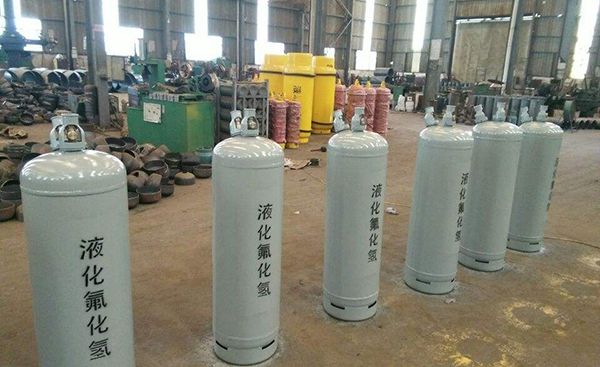Hydrogen Fluoride
Release Date: 2022-06-16 10:27:16 Visit: 161

Hydrogen fluoride is an inorganic compound with the chemical formula HF. Under normal conditions, it is a colorless, pungent odor toxic gas with very strong hygroscopicity. It produces white smoke upon contact with air. It is easily soluble in water and can be mixed with water. Water dissolves infinitely in each other to form hydrofluoric acid. Hydrogen fluoride has intermolecular hydrogen bonds and can exhibit some abnormal properties, such as a much higher boiling point than other hydrogen halides. Hydrogen fluoride is very chemically reactive and can react with many compounds. Hydrogen fluoride as a solute is a weak acid, while pure hydrogen fluoride is a strong acid.
Physical and Chemical Properties
Hydrogen fluoride (HF) is a colorless, pungent, toxic gas under normal conditions. It is easily soluble in water and infinitely miscible with water to form hydrofluoric acid. Hydrogen fluoride is hygroscopic and will "smoke" after absorbing moisture in the air; melting point -83.37℃, boiling point 19.51℃, gas density 0.922 kg/m3 (standard state), relative molecular weight 20.008.
Hydrogen fluoride has associative properties due to intermolecular hydrogen bonds and exists in the form of associative molecules (HF). basically become a single molecule state. Due to intermolecular association, hydrogen fluoride has a much higher boiling point than other hydrogen halides and exhibits some anomalous properties.
Hydrogen fluoride is chemically reactive and reacts with many compounds. As a solute (in aqueous solution), it is a weak acid, and as a solvent, it is a strong acid, which is equivalent to anhydrous sulfuric acid, can react with oxides and hydroxides to generate water, and can undergo substitution reactions with metal compounds of chlorine, bromine and iodine. Can react with most metals, and react with some metals (Fe, Al, Ni, Mg, etc.) to form a fluoride protective film that is insoluble in HF; in the presence of oxygen, copper is quickly corroded by HF, but in the absence of oxidants, It will not react; some alloys such as Monel have good corrosion resistance to HF, but the corrosion resistance of stainless steel is very poor, and carbon steel also has sufficient corrosion resistance when the temperature is not too high.
Similar to water, hydrogen fluoride has a large dielectric constant (83.6 at 0°C), and is an ideal solvent for solvolysis reactions with solutes. In addition, anhydrous hydrogen fluoride has strong proton-donating ability and strong dehydration ability. Once wood and fiber are in contact with it, they will carbonize immediately, and will form polymers after contacting with organic compounds such as alcohols, aldehydes, and ketones. , weak phosphoric acid.
Hydrogen fluoride is not flammable, but it is dangerous when mixed with some substances (such as sodium, calcium oxide, methyl nitrate, sodium chlorate, etc.).
Hydrogen fluoride is a basic chemical product, and anhydrous hydrogen fluoride is a raw material for electrolysis to produce elemental fluorine; in the chemical industry, it is widely used in the chemical industry to replace chlorine in halogenated hydrocarbons to produce chlorofluorocarbons, such as difluorodichloromethane (F12) and difluorocarbons. Monochloromethane (F22), etc.; in the petrochemical industry, it is used as a liquid catalyst for the alkylation of aromatic hydrocarbons and aliphatic compounds to produce high-octane gasoline. [1]
In the electronics industry, anhydrous hydrogen fluoride is used as a raw material for electrolytic synthesis of nitrogen trifluoride, as an etchant in semiconductor manufacturing processes, etc. In addition, hydrogen fluoride is used in the industrial production of hydrofluoric acid, the production of inorganic fluorides, uranium processing, metal processing, and etching agents in the glass industry.
Packaging and Storage
Packaging: copper, iron, nickel, silver platinum or monel alloy containers are often used, and steel pressure containers lined with plastic or fluoroplastic are used in the case of pressure operation; gas cylinders are seamless steel cylinders with low silicon content, Use nickel or nickel-based alloys, monel materials at high temperatures. The sealing material can be fluororubber, polytetrafluoroethylene, polychlorotrifluoroethylene, etc. under normal temperature and pressure, and polytetrafluoroethylene is used within 250 °C, and copper gaskets are recommended for higher than 250 °C. The filling pressure of hydrogen fluoride is 2.0MPa, and the filling coefficient is 0.83 kg/L.
Storage and transportation: The hydrogen fluoride cylinder is stored in a cool, ventilated warehouse with an indoor temperature not exceeding 40°C. Fireworks are strictly prohibited, keep away from fire and heat sources, and prevent direct sunlight and rain; gas cylinders should be equipped with safety protection caps, which should be stored upright and fixed. Leak detection and alarm devices are installed in the warehouse, and leak-stopping and emergency treatment devices (such as automatic sprinkler devices, etc.) are provided, and regular inspections are made to make records.





